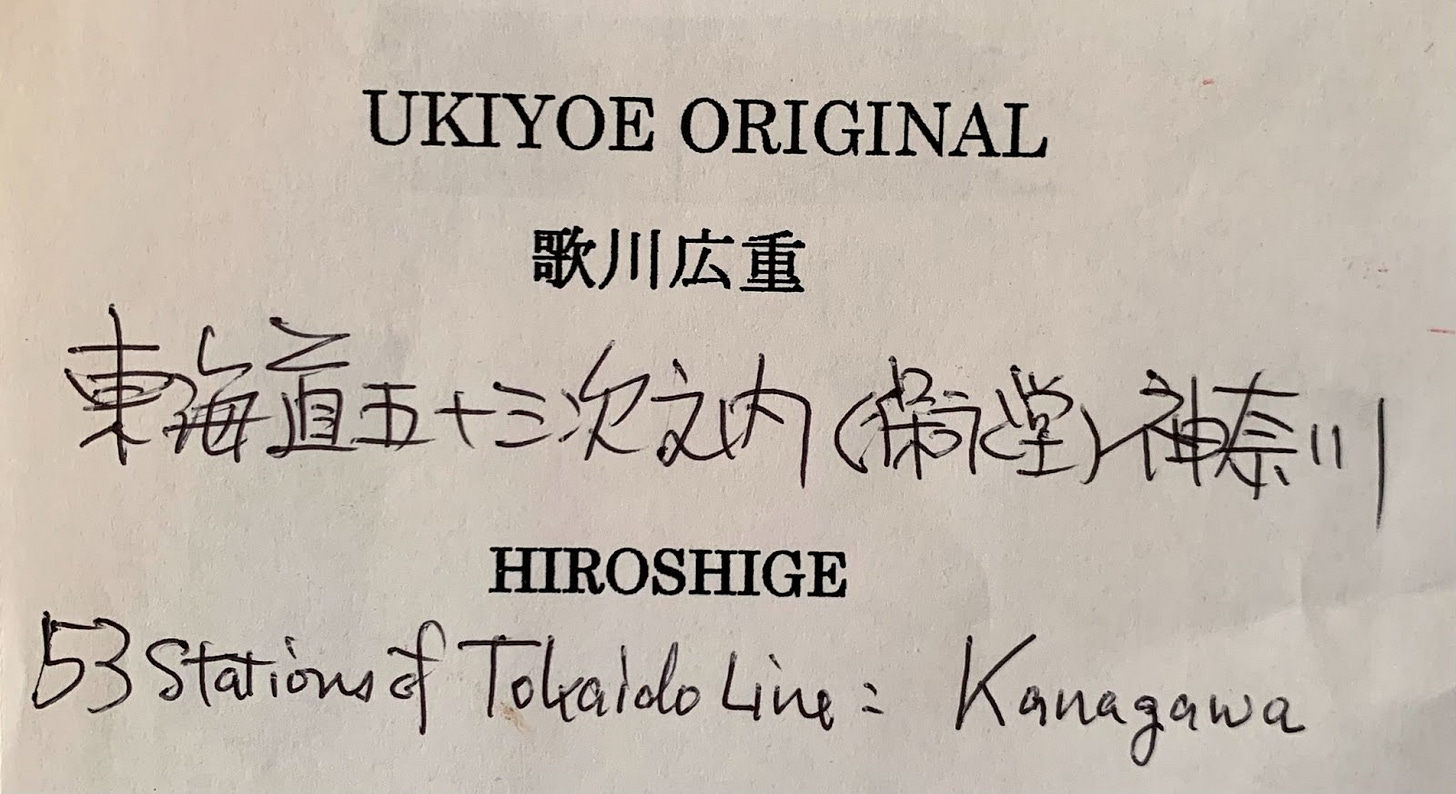Hiroshige, Meguro Drum Bridge and Sunset Hill, 1856-1858
Welcome to Artobiography – your go-to source for the stories and insights behind the world's most captivating art.
In the previous newsletter, I mentioned how much Vincent van Gogh was influenced by Japanese art. Van Gogh collected Japanese prints and displayed them wherever he lived.
I also love Japanese art. I find it peaceful and serene. Years ago, when my husband traveled to Japan, he purchased a ukiyo-e woodcut print created by Utagawa Hiroshige from the series The Fifty-Three Stations of the Tokaido.
While I loved his work, I didn’t know much about Hiroshige until now…
The Artist: Hiroshige
Hiroshige was born in 1797 in Edo, present-day Tokyo. Coming from a samurai family, he discovered his passion for painting early in life. Despite his talent, it took years for his work to gain recognition.
His major breakthrough came in 1832 with The 53 Stations of the Tokaido, a series that captured the scenic and culturally significant locations along the famous Tokaido Road. This series not only brought Hiroshige fame but also established him as a leading artist of the Ukiyo-e genre.
Hiroshige lived during the Edo period, a time marked by significant cultural and economic transformation in Japan. A flourishing arts scene emerged alongside the rise of a wealthy and educated urban middle class. This new audience sought art that reflected their own experiences and the world around them.
Hiroshige responded with prints that showcased Japan's landscapes and the lively scenes of its cities and countryside, reflecting the spirit of a nation in transition.
Hiroshige's prints became treasured not only for their aesthetic beauty but also for their narrative quality and cultural relevance. They were collected, traded, and displayed in homes as tokens of travel, symbols of sophistication, or simply as beautiful depictions of the beloved Japanese landscape.
During Hiroshige's time, woodblock prints were an affordable and popular art form, sometimes costing as much as a bowl of noodles. This affordability made his work widely accessible and beloved across different social classes. As a result, Hiroshige's prints were not just artworks. They became a part of everyday life for many people.
Hiroshige's landscapes had a significant influence on European artists, especially the Impressionists, who were drawn to his innovative portrayal of nature and urban landscapes. His ability to capture the beauty of the natural world and the bustling life of Edo opened new artistic possibilities and bridged Eastern and Western art traditions.
His work, particularly One Hundred Famous Views of Edo, introduced fresh techniques and perspectives that captivated artists like Vincent van Gogh.
Van Gogh owned over four hundred Japanese woodblock prints and regularly studied them, especially admiring Hiroshige's compositions. He was drawn to their bold, bright colors and distinctive lines, integrating these elements into his own art.
Original video: Hiroshige: Van Gogh’s Favorite Japanese Artist
Van Gogh's passion led him to organize exhibitions of Japanese prints, including one in 1887 at the Cafe Tambourin in Montmartre, Paris, which he and his brother Theo hosted. These exhibitions provided the public with a unique opportunity to experience the beauty and influence of Japanese art.
The Art: Meguro Drum Bridge and Sunset Hill
Meguro Drum Bridge and Sunset Hill is part of Hiroshige's One Hundred Famous Views of Edo series, capturing a serene scene in Edo. This artwork is renowned for its vibrant colors and intricate details, providing viewers with a sense of tranquility and the fleeting nature of time. The series as a whole offers a comprehensive view of Edo's cultural and historical landscape during a time of peace and prosperity.
As the world's largest city in the 18th century and Japan's political capital, Edo provided a wealth of inspiration for Hiroshige. One Hundred Famous Views of Edo serves as both a tribute to the city's beauty and a comprehensive record of its spirit.
The series, comprising 118 prints, was created between 1856 and 1858 and is considered Hiroshige's final masterpiece. It remains a precious record of Edo's appearance and spirit at the end of a long era of peace.
One Hundred Famous Views of Edo stands as a testament to the lasting appeal and cultural significance of Hiroshige's work, symbolizing artistic innovation and cross-cultural exchange.
Sources:
Dayman, L. (2021, January 22). Masterpieces by Hiroshige: 53 stations of the Tokaido. Japan Objects. https://japanobjects.com/features/hiroshige-tokaido
Gowing, L. (1995). A Biographical Dictionary of Artists. Checkmark Books.
Hiroshige (1797 - 1858). (n.d.). Ronin Gallery. https://www.roningallery.com/kanbara-jpr-104062
Hiroshige’s one hundred famous views of Edo. (n.d.). Brooklyn Museum. https://www.brooklynmuseum.org/features/edo
Schlombs, A. (2016). Hiroshige. Taschen.
********
What is your favorite art? What artist would you like me to research next?





Thank you for exposing me to this. Look forward to exploring more.